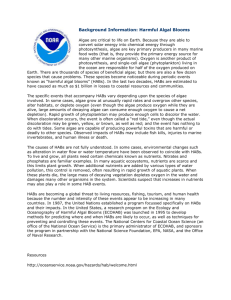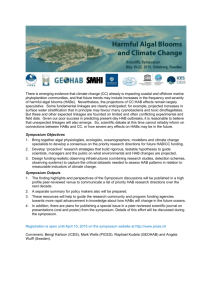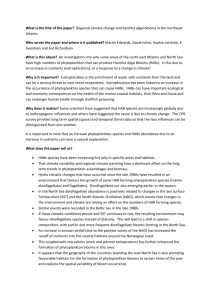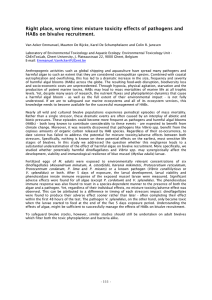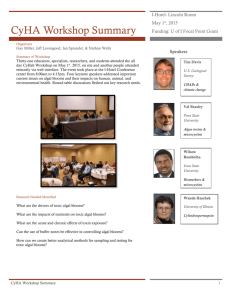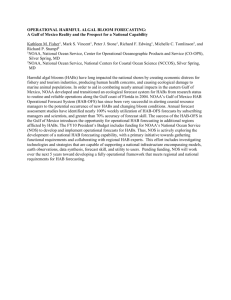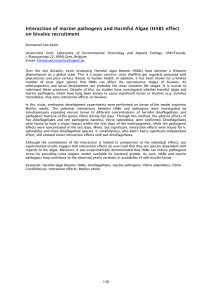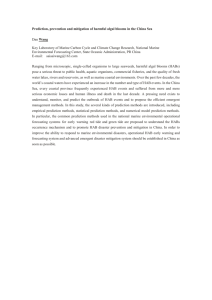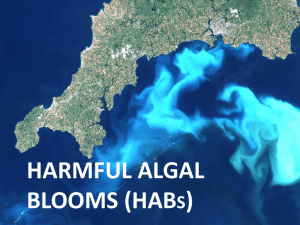Harmful Algal Blooms A scientific summary for policy makers
advertisement
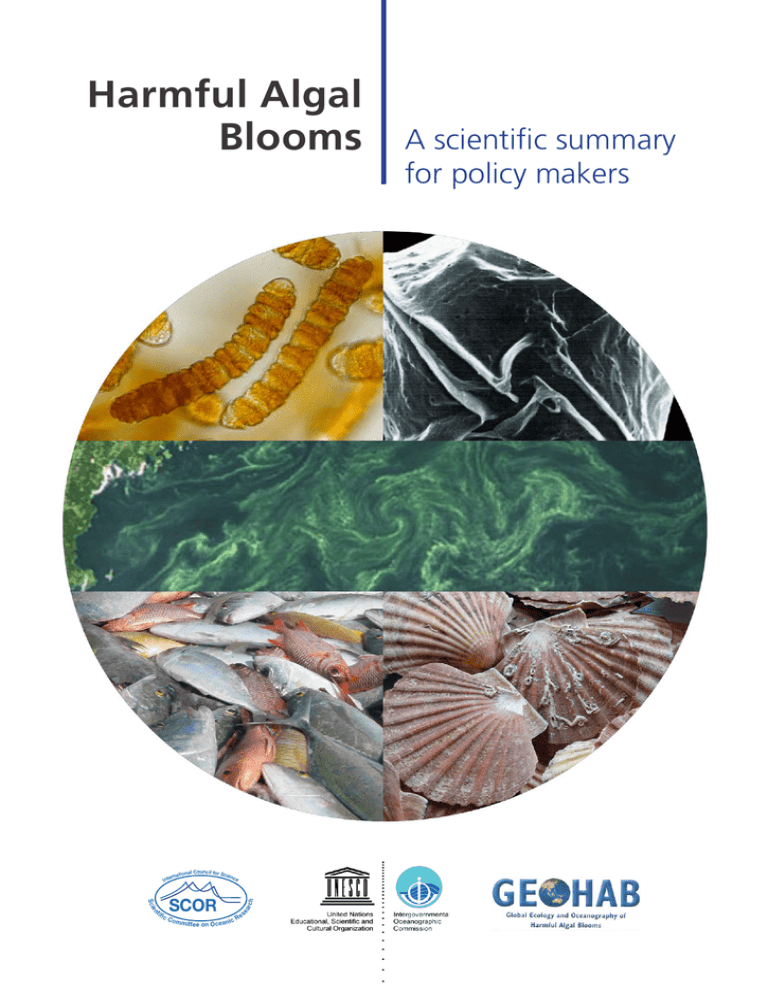
Harmful Algal Blooms n ic SCOR Com m it t e e o n O c e a n i c ea S cie tif rch ouncil for S tional C cien ce erna Int Re s A scientific summary for policy makers Acknowledgements This report was prepared by the SCOR-IOC Scientific Steering Committee of the Global Ecology and Oceanography of Harmful Algal Blooms research programme GEOHAB, with contributions from colleagues. GEOHAB (1998-2014) is an international programme that focuses research effort on comparative studies of harmful algae population dynamics, and is sponsored by the Scientific Committee on Oceanic Research (SCOR) and the Intergovernmental Oceanographic Commission (IOC) of UNESCO. Thanks to all the people that actively participated in the GEOHAB programme including members of the SSC, participants at the Open Science Meetings, ­members of the endorsed projects and activities. This has helped to build an international cooperative community fostering research on the ecology and oceanography of harmful algal blooms. Authors: R.M. Kudela (UCSC), E. Berdalet (ICM, CSIC), S. Bernard (CSIR-NRE), M. Burford (ARI-UG), L. Fernand (CEFAS), S. Lu (JU), S. Roy (UQAR), P. Tester (NOAA), G. Usup (UKM), R. Magnien (NOAA), D. M. Anderson (WHOI), A. Cembella (AWI), M. Chinain (ILM), G. Hallegraeff (UT), B. Reguera (IEO), A. Zingone (SZN), H. Enevoldsen (IOC), Ed Urban (SCOR). For bibliographic purposes this document should be cited as: R.M. Kudela et al. 2015. Harmful Algal Blooms. A Scientific Summary for Policy Makers. IOC/UNESCO, Paris (IOC/INF-1320). Design: Leif Bolding, Dept of Biology, University of Copenhagen Cover image credits: M. Chinain, Defra Crown ©, M. Kahru, K. Matsuoka. 2 Table of Contents Summary & Key Points...................................................................... 4 What is a Harmful Algal Bloom (HAB)?.............................................. 5 How do HABs Affect Us?................................................................... 6 Why are HABs a Global Problem?...................................................... 7 Overview of the Worldwide Problem ................................................. 10 What Causes HABs?.......................................................................... 12 What are the Costs of HABs?............................................................ 13 What are the Solutions to HABs......................................................... 14 International Cooperation................................................................. 16 New Technologies ............................................................................ 17 List of Publications............................................................................ 18 Contact ........................................................................................... 20 Fish farms in South Korea, threatened by HABs in the last decade. Photo: R. Kudela. 3 Summary & Key Points • Harmful Algal Blooms (HABs) result from noxious and/or toxic algae that cause direct and indirect negative impacts to aquatic ecosystems, coastal resources, and human health. • HABs are present in nearly all aquatic environments (freshwater, brackish and marine), as naturally occurring phenomena. • Many HABs are increasing in severity and frequency, and biogeographical range. Causes are complex, but in some cases can be attributed to climate change and human impacts, including eutrophication, habitat modification, and human-mediated introduction of exogenous species. • There is no plan, and nor realistic possibility, to eliminate HABs and/or their dependent consequences. Decades of research and monitoring have, however, improved our understanding of HAB events, leading to better monitoring and prediction strategies. • HABs are a worldwide phenomenon requiring an international understanding leading ultimately to local and regional solutions. Continued progress in research, management, mitigation, and prediction of HABs benefits from international coordination. In this spirit, the international community has developed programmes sponsored by the Intergovernmental Oceanographic Commission (IOC) and Scientific Committee on Oceanic Research (SCOR) to coordinate international HAB research, framework activities, and capacity building. • HABs are recognized as one facet of complex ecosystem interactions with human society. HAB research, monitoring, and management must be closely integrated with policy decisions that affect our global oceans. • New initiatives, such as GlobalHAB sponsored by IOC and SCOR, will continue to provide the mechanisms to further understand, predict, and mitigate HABs. Research, management, and mitigation efforts directed towards HABs must be coordinated with other local, national, and international efforts focused on food and ­water security, human and ecosystem health, ocean observing systems, and ­climate change. 4 What is a Harmful Algal Bloom (HAB)? Photosynthetic algae support healthy aquatic ecosystems by forming the base of the food web, fixing carbon and producing oxygen. Under certain circumstances, some species can form high-biomass and/or toxic proliferations of cells (or “blooms”), thereby causing harm to aquatic ecosystems, including plants and animals, and to humans via direct exposure to water-borne toxins or by toxic seafood consumption. Ecosystem damage by high-biomass blooms may include, for instance, disruption of food webs, fish-killing by gill damage, or contribution to low oxygen “dead-zones” after bloom degradation. Some species also produce potent natural chemicals (toxins) that can persist in the water or enter the food web, leading to illness or death of aquatic animals and/or human seafood consumers. A high-biomass but non-toxic bloom of the marine dinoflagellate ­Noctiluca scintillans. The term “Harmful Algal Bloom” (HAB) is a socio-economic but not strictly scientific descriptor because it refers to human perception of “harmfulness” and the variety of negative events caused by algae, including some cyanobacteria and macroalgae. During high-biomass harmful blooms, algae reach high cell concentrations, which can shade the growth of other aquatic plants and algae, disrupt aquatic fauna, and produce low-oxygen dead zones when the algae degrade. In some cases, these events may affect the aesthetic value of the coastal zone, impairing recreational use and tourism. Some high-biomass blooms can be caused by species that produce toxins (e.g., Pyrodinium bahamense) whereas other blooms are of non-toxic and otherwise innocuous algae (e.g., Alexandrium taylorii, Noctiluca spp.). Blooms of microscopic algae that discolor the water have traditionally been called red tides, whether toxigenic or not. Other HAB events are caused by highly toxic microalgae (e.g., Dinophysis species) at low (and essentially invisible) cell abundances. In both low- and high-biomass ­toxic blooms, microalgae are ingested by shellfish or other marine organisms which can bioaccumulate the toxins and transfer them through the food web to wildlife and humans. Toxins may not appear to affect some organisms, while in other cases they can lead to acute illness or death in aquatic fauna and human seafood consumers. HABs occur in all latitudes and aquatic systems, including marine, brackish and freshwater. While they most dramatically affect human activities when they ­occur in coastal and inland waters, HABs are also present even in sparsely settled coastal regions and in offshore areas. 5 How do HABs Affect Us? Impacts on Human Health HABs negatively affect health of humans and aquatic animals and plants, and in some cases, ecosystem functioning. Occurence of HABs can lead to impaired seafood security and decreased water quality. Impacts can be acute and severe, or more prolonged and chronic. The frequency, intensity, and distribution of HABs seem to have increased during the past several decades. While some of this apparent increase is related to increased awareness and better monitoring, there is also evidence for expansion of some known HABs, and, at times, iden­ tification of new HAB organisms and impacts. Recurrent blooms of Dinophysis, associated to DSP, cause long lasting mussel (Mytilus galloprovincialis) harvesting closures in the Galician Rías Baixas (Spain). Photo: INTECMAR (Xunta de Galicia). Toxins produced by HABs are associated with several syndromes, including Paralytic (PSP), Diarrheic (DSP), Amnesic (ASP), and Ciguatera (Shell)Fish Poisoning (CFP), caused by consumption of contaminated seafood. Toxins are bioaccumulated by organisms that ingest algae, and thus transmitted through the food web up to humans. Health symptoms include: • gastrointestinal disorders: nausea, ­vomiting, diarrhea (in most syndromes); • neurologic and muscular problems: numbness of mouth and extremities, which can persist for several months in the case of CFP; paralysis of the muscles of the chest and abdomen possibly leading to death (PSP); headache, dizziness, confusion, disorientation, short-term memory deficits, and motor weakness (ASP); • exposure to toxic aerosol from algae can cause respiratory problems (in the Gulf of Mexico associated with Karenia blooms and in the Mediterranean with Ostreopsis outbreaks); • most of these toxin syndromes are well documented, but scientists occasionally describe new issues such as Azaspiracid Shellfish Poisoning (AZP), identified in the 1990s. 6 How do HABs Affect Us? Impact on Organisms and the Environment High-biomass events can cause ecological and/or economic damage without producing toxins. For example, the massive red tide of the non-toxic dinoflagellate Akashiwo sanguinea in the Pacific Northwest (United States) resulted in the largest documented marine bird mortality event, linked to production of foam that destroyed the waterproof characteristics of the bird feathers. Infamously, the non-toxic seaweed Ulva disrupted the 2008 Olympics in China. Moreover, the rapid expansion of desalination systems globally, with more than 17,000 plants in 150 countries worldwide, has led to increasing concern about HAB events. In the case of the 2008/09 Cochlodinium red tide in the Middle East, this led to disruption of water production and massive economic losses, including those from mariculture fish mortalities and negative impacts on tourism and coastal aesthetics. Foam produced by the dinoflagellate Akashiwo sanguinea caused a massive bird mortality event in the Pacific Northwest. Photo: Penelope Chilton, COASST. Infamously, the nontoxic seaweed Ulva disrupted the 2008 Olympics in China, and has recurred every year since in extraordinary quantities. Chronic exposure to some toxins is an area of emerging concern. For example, microcystins, produced by certain species of both freshwater and marine cyanobacteria, have been linked to tumor promotion, liver damage, and death in humans, as well as impaired development in fish and zooplankton. Domoic acid exposure is associated with epilepsy-like seizures in marine mammals; very little is known about the longterm impacts on humans from this and other algal toxins. A Microcystis cyanobacterial bloom in Pinto Lake, California. Image: R. Kudela. 7 Why are HABs a Global Problem? Today, regardless of where we live, we are connected to aquatic systems. While harmful algae may be more apparent in some locations, the potential impacts are farreaching, touching every location around the globe. Every country with a coastline, and every region that has freshwater reservoirs can harbor marine and freshwater HABs. The ability to transport organisms globally, e.g. in ship ballast water, has exacerbated the problem. Massive mortalities of wild animals (turtles, dolphins, manatees, whales, birds) have been linked to the microalgal toxins accumulating in food webs. In the last few decades, algal toxins were responsible for the death of 19 humpback whales off Cape Cod (USA), and probably of pygmy, dwarf sperm, and North Atlantic right whales. The US National Oceanic and Atmospheric Administration estimates that more than 50% of all Unusual Mortality Events (UMEs) are due to algal biotoxins. While not proven, HABs could also have been involved in Southern right whale mortalities in Peninsula Valdés (Argentina). In 2000, four captive penguins died in a zoo in Kentucky, USA (far from the ocean) after consuming herring and anchovies collected from Monterey Bay, CA (USA), a known hotspot for domoic acid-producing diatoms (the cause of Amnesic Shellfish Poisoning). In the Pacific Ocean region, cyanobacterial blooms in coral reefs and oceanic waters are occurring more and more often. They constitute a risk for local populations, because they produce toxins that are transferred along the food chain and affect fish and mollusks. The image shows a Trichodesmium bloom near the SPOT (South Pacific Ocean Time series) station (20ºS, 168ºE), off of ­Ouvéa and Lifou islands (New Caledonia), December 2014. “With every drop of water you drink, every breath you take, you’re connected to the sea. No matter where on Earth you live. Most of the oxygen in the atmosphere is generated by the sea.” Sylvia Earle, first female chief scientist of the U.S. National Oceanic and Atmospheric Administration. 8 Ciguatera Fish Poisoning (CFP) is the main cause of natural, non-bacterial illness ­associated with seafood consumption worldwide. CFP is a significant public health issue in the Pacific Ocean region and in all parts of the world where coral reefs are found, such as the Caribbean Sea. There is limited information on the actual incidence of CFP globally, but this disease is estimated to affect 25,000 to 50,000 people annually. However, in many instances, these statistics are highly unreliable due to the under-reporting or misdiagnosis of illnesses. It is estimated that <0.1% of poisoned persons in the Caribbean islands consult a physician, while in the South Pacific, the incidence figures likely represent only 20% of the actual cases. Ciguatoxins are cumulative, persistent, and the debilitating symptoms of CFP often recur. However, there is no acquired immunity, vaccination, cure nor effective treatment of symptoms. Nowadays, procedures to protect human populations in these areas are still lacking. There is an urgent need to develop and validate reliable and cost-effective tools to rapidly identify the causative organisms and detect toxicity in fish. Increased travel and international trade in seafood are causing the spread of CFP to non-tropical, higher latitude countries. In 2012, 14 patients were diagnosed with CFP in Germany M. Chinain after eating contaminated red snapper imported from tropical waters. In Europe, procedures for the control of ciguatoxins in imported seafood are now underway, whereas strategies to understand and cope with the risk posed by emerging toxins are still required. In 1996, patients in a dialysis centre in Caruaru (Brazil) were exposed to microcystins, through contaminated serum, resulting in 116 of 130 patients exhibiting acute poisoning symptoms, with 26 mortalities. 9 A worldwide problem requires an interna In the Gulf of Maine, Canada and USA, blooms of Alexandrium fundyense cause PSP in shellfish consumers. Images: D.M. Anderson. Akashiwo sanguinea outbreaks produced foam, involved in bird mortality. Images: R. Kudela. In the Mediterranean, high-biomass blooms of the epiphyte Ostreopsis are associated with respiratory irritations in beach users. Images: J.M. Fortuño, M. Vila, ICM-CSIC. Macroalgal (Chaetomorpha linum) blooms are linked to eutrophication in touristic area of Colombia. Photo: M. Wainwright. 10 Blooms of Alexandrium catenella in the Chilean fjords impact the shellfish industry and may kill people. Images: L. Guzmán, R. Kudela. An anoxic Ceratium b killed 2,000 tons of US$50 million Photo of Cape Town. ational understanding and a local solution In the Baltic cyanobacteria blooms prevent recreational use of the coast in summer. Photo: B. Karlson, SMHI. bloom in South Africa rock lobster and cost o: G. Pitcher, University In Asian waters eutrophication associated with high-biomass blooms cause severe fish kills in aquaculture sites. High-biomass blooms shut down desalination plants, and the toxic species constitute an additional risk to the freshwater supply. Image: R. Kudela. Ciguatera Fish Poisoning (CFP), caused by Gambierdiscus, is an endemic sea-food borne intoxication in the Pacific Islands and the Caribbean. Images: M. Chinain, M. Faust. In Australia cyanobacterial blooms in freshwater reservoirs threaten drinking water supply. Photo: M. Burford. 11 What Causes HABs? HABs are caused by a naturally occurring subset of aquatic algae, mostly microscopic, that can float or swim (phytoplankton) or attach to underwater surfaces (as phytobenthos).Their growth rate and biomass generated is dependent upon a combination of natural physical, chemical, and biological factors: light, nutrients, temperature, salinity, water circulation, competition with and predation by other organisms in the food web. In turn, human activities contribute to HABs worldwide through impacts such as nutrient pollution, intensive use of coastal zones, alteration of water circulation dynamics, dispersion of species through ships ballast waters, etc. While HABs are a natural component of any aquatic ecosystem, human activities can exacerbate frequency, intensity and occurrence of HAB events. Image: A. Joyner, UNC-CH Institute of Marine Sciences. Eutrophication, or excessive enrichment of an ecosystem with nutrients, is one direct impact from humans that can lead to more HABs. Aquaculture activities can contribute to nutrient pollution in regions such as Cam Ranh Bay, Vietnam. Photo: Y. Fukuyo. Below: Simplified scheme of the succession of main phytoplankton groups, varying with nutrient availability and mixing of the water column. Image: R. Kudela, modified from F.G. Figueiras. Natural succession provides a seasonal “rhythm” to many marine ecosystems, including occurrence of HABs. By understanding succession scientists can predict the occurrence of HABs, and also begin to address how HAB frequency and abundance may change with our changing climate. HABs cannot easily be eliminated or prevented, but they can be monitored and predicted, and the potentially negative consequences can be managed and mitigated. Changes in human activities and behaviour could also contribute to prevent or minimize certain HABs and their deleterious effects. 12 What are the Costs of HABs? Present and Future Perspectives It is not easy to quantify the true cost of HABs, because they have an impact on human health and ecosystem services at several levels. The economic damage to certain human activities and concerns (fisheries, aquaculture, tourism, desalination plants, drinking water supply, health care) can be estimated. In addition, the cost associated with HAB research, monitoring, and mitigation should be considered, because these activities can diminish the economic losses. There is currently no comprehensive global assessment of economic loss due to marine and freshwater HABs, but it can be conservatively estimated at several billion U.S. ­dollars annually. In freshwater systems potential eutrophication-related losses are ­primarily due to cyanobacteria blooms. CONSERVATIVE ANNUAL COST Marine HABs USA Europe Asia ± US$ 95 million > US$ 850 million > US$ 1 billion Freshwater HABs USA ± US$ 4,6 billion China ± US$ 6,5 billion (1998, Lake Tai) Australia ± US$ 150 million UK ± US$ 150 million South Africa ± US$ 250 million Using a typical Value of Information estimate of 1% of the “resource” (in this case HAB-related losses), a comprehensive global HAB observing and forecasting information system would represent a value of ± $100 million annually, one-tenth of the direct cost. In the near future, HAB-related costs are going to increase because of our ever increasing need to exploit marine resources, while global climate change may make their occurrence more unpredictable. Although predicting the impact of a shifting climate on HABs is complex, the available data indicate that range expansion of harmful species, changes in algal community dynamics, and impacts to formerly unaffected ecosystems, as well as impacts from previously unknown HAB organisms, are already occurring. Source: Bernard et al., 2014, Developing global capabilities for the observation and prediction of harmful algal blooms. Oceans and Society: Blue Planet. Cambridge Scholars Publishing. PICES Scentific Report, No. 47, 2014. http://pices.int/publications/ scientific_reports/ Increasing eutrophication through on-going development and increased resource pressure, particularly in coastal and shelf-sea areas, is also likely to exacerbate the global HAB problem, with the potential for increased proliferation of freshwater and marine cyanobacteria. Effective HAB monitoring and research strategies can contribute to alleviate these negative impacts. Coordinated efforts by the scientific community, policy makers, and end users are the best approach to decrease the costs of HABs, and to mitigate the potential impacts of climate and global change. 13 What are the Solutions to HABs? Efforts have been made worldwide to prevent and mitigate the negative effects of HABs in the last few decades. The most successful advances have been achieved through coordinated HAB monitoring and scientific research, integrated with end users and management through effective and informed policy decisions. The main elements required to cope with HABs include: • Sustained support of monitoring and management. These activities provide information and alerts to the public about human and ecosystem health threats. The continuation of ongoing programmes and establishment of new efforts require longterm commitments at local, regional, national, and international levels. These programmes also provide the baseline information for understanding how HAB frequency and abundance are changing. • Prevention of HABs. The extent and duration of blooms can be reduced for many HAB species by changing some human activities that impact our seas and oceans, such as decreasing nutrient pollution, minimizing spread through ballast water transport, limiting infrastructure construction (harbours, artificial beaches) that facilitate water confinement and modify circulation patterns, and designing ecologically sustainable aquaculture sites. A more sustainable use of the coastal zone for e.g., aquaculture purposes will help to decrease the risk of HABs events. In the image: Mega-scale shrimp culture farm (18,000 ponds) in Indonesia. Photo: IOC/Westpac-HAB. 14 HAB monitoring often relies on trained volunteers who collect samples weekly using simple but robust methods. These data can be augmented with more sophisticated monitoring and modelling tools. Photo: R. Kudela. • Modelling and Prediction. Nowadays, a few HABs can be modeled and predicted on a regional scale with some success. Future progress depends heavily not only on the creativity and innovation of individual investigators developing new models and new approaches, but also on integration with the broader community of researchers dealing with physical-biological interactions of algae populations. • Research. HAB research has markedly progressed in recent years, in part with advances in technology. Continued support of research into HAB biology, fate of toxins, and ecology will contribute to decrease their effects, especially those with complex dynamics. • International Coordination. Since its establishment in 2000, the GEOHAB programme fostered international co-operative research on HABs in ecosystem types sharing common features, comparing the key species involved and the oceanographic processes that influence their population dynamics. Its success was based on support at national level for the goals and objectives. The same spirit underlies the newly established GlobalHAB, because a worldwide problem requires an international understanding to target local and regional solutions. The international programme GlobalHAB is the next generation of GEOHAB 15 International Cooperation in Support of ­National Management Harmful Algal Blooms are a global issue that requires international cooperation and local solutions, integrating scientific research, policy makers, the general public and stakeholders involved with all levels of HAB impacts. While HABs are naturally occurring, and cannot be eliminated, the negative impacts can be alleviated through coordinated research, monitoring, prevention policies and mitigation plans. Progress can be made by supporting regional and national programmes, and the international framework that are already available and that have been working successfully for the past decades. GlobalHAB is one example of an international coordinating programme. GlobalHAB will advance international collaboration on HABs, improve predictive capability and understanding of mechanisms leading to HABs, and will inform science and policy linking HABs with societal needs and impacts. The IOC Intergovernmental Panel on Harmful Algal Blooms (IPHAB), coordinates actions at a policy level among countries and has recently endorsed an UN interagency strategy for improving management of Ciguatera Fish Poisoning. HABs are a global phenomenon and many countries have a long history of research and management responses. HABs are closely linked to many The Global HAB Status Report, by the IOC UNESCO, other societal issues includIAEA, PICES and ICES, is based on data from various ing climate change, food and sources including OBIS and IODE/HAEDAT and will comwater security, and sustainaplement broader environment assessments. ble use of our freshwater and ocean ecosystems. Informed management and policy decisions require that HABs be recognized as one facet of complex ecosystem interactions with human society, and HAB research, monitoring, and m ­ anagement must be closely integrated with policy decisions that affect our global oceans. 16 New Technologies are Allowing a Better Comprehension of the HAB Problem The TurboMap-G (H Yamazaki, Japan) device allows us to understand the small-scale physical hydrodynamics that control the aggregation of toxic microalgae in thin layers in the water column. Photo: H. Yamazaki. The Environmental Sample Processor (MBARI, US) is a robotic biochemistry laboratory that detects some toxic microorganisms in the ocean in real time. Photo: R. Kudela. Satellites and oceanographic models of ­water circulation allow monitoring and ­prediction of high biomass blooms and ­reduction of their impacts on fisheries. Above: distribution on toxic microalgae in the Chesapeake Bay (left) and modeled bloom abundances (right). From Anderson et al. 2010. J. Mar. Sys. Left: satellite image of chlorophyll concentration, tracking a phytoplankton bloom off the coast of South Africa. Image: S. Bernard. 17 List of Publications GEOHAB Publications: GEOHAB Reports and Documents including the Science Plan, Implementation Plan, and Core Research Project reports (from 2000 to 2014) are ­available online: www.geohab.info Real-time Coastal Observing Systems for Marine Ecosystem Dynamics and Harmful Algal Blooms: Theory, Instrumentation and Modelling. 2009, HABWatch Monograph, UNESCO Publishing Oceanography. 2005, special volume 18 Harmful Algae. 2008, special volume 8 Progress in Oceanography. 2010, special volume 85 Chinese Journal of Oceanology and Limnology. 2010, special volume 29: 719-916, on Eutrophication and HABs Deep-Sea Research, Part II: Topical Studies in Oceanography. 2014, special volume 101, on HABs in Stratified Systems Implementa tion Plan 18 Cyanobacterial blooms in Lake Taihu, China’s third largest lake, have led to a drinking water crisis. Photo: M. Burford. Epifluorescence (blue light) micrograph (100x) of a live con­centrated microplankton population dominated by Dinophysis acuminata (orange autofluorescence) and Prorocentrum micans (red autofluorescence). Ría de Pontevedra, Galicia, NW Spain, May 2005. Photo: Sonsoles GonzálezGil. 19 Contacts Intergovernmental Oceanographic ­Commission (IOC) United Nations Educational, Scientific and Cultural Organization 7 Place de Fontenoy, 75352 Paris Cedex 07 France Tel: +45 23 26 02 46 Email: hab.ioc@unesco.org hab.ioc-unesco.org or ioc.unesco.org ic Com m it t e e o n O c e a n i c rch SCOR ea tif n IOC-SCOR GlobalHAB Research Programme www.globalhab.info ouncil for S tional C cien ce erna Int S cie Scientific Committee on Oceanic Research (SCOR) College of Earth, Ocean, and Environment Robinson Hall University of Delaware Newark, DE 19716, USA Tel: +1-302-831-7011 Fax: +1-302-831-7012 Email: secretariat@scor-int.org www.scor-int.org Re s

